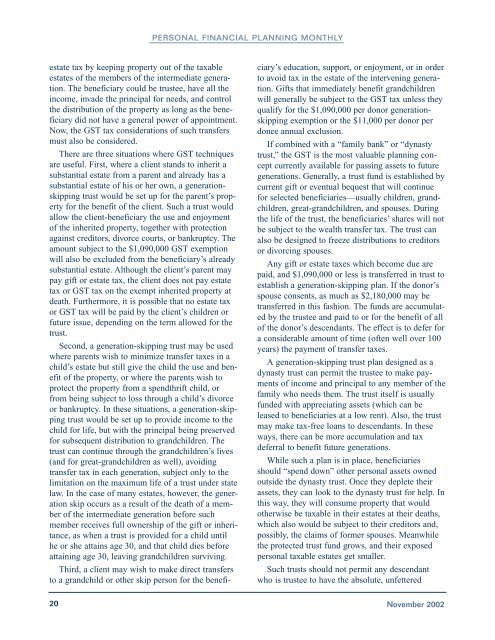Personal Financial Planning Monthly - Editorial Direction LLC
Personal Financial Planning Monthly - Editorial Direction LLC
Personal Financial Planning Monthly - Editorial Direction LLC
You also want an ePaper? Increase the reach of your titles
YUMPU automatically turns print PDFs into web optimized ePapers that Google loves.
PERSONAL FINANCIAL PLANNING MONTHLY<br />
estate tax by keeping property out of the taxable<br />
estates of the members of the intermediate generation.<br />
The beneficiary could be trustee, have all the<br />
income, invade the principal for needs, and control<br />
the distribution of the property as long as the beneficiary<br />
did not have a general power of appointment.<br />
Now, the GST tax considerations of such transfers<br />
must also be considered.<br />
There are three situations where GST techniques<br />
are useful. First, where a client stands to inherit a<br />
substantial estate from a parent and already has a<br />
substantial estate of his or her own, a generationskipping<br />
trust would be set up for the parent’s property<br />
for the benefit of the client. Such a trust would<br />
allow the client-beneficiary the use and enjoyment<br />
of the inherited property, together with protection<br />
against creditors, divorce courts, or bankruptcy. The<br />
amount subject to the $1,090,000 GST exemption<br />
will also be excluded from the beneficiary’s already<br />
substantial estate. Although the client’s parent may<br />
pay gift or estate tax, the client does not pay estate<br />
tax or GST tax on the exempt inherited property at<br />
death. Furthermore, it is possible that no estate tax<br />
or GST tax will be paid by the client’s children or<br />
future issue, depending on the term allowed for the<br />
trust.<br />
Second, a generation-skipping trust may be used<br />
where parents wish to minimize transfer taxes in a<br />
child’s estate but still give the child the use and benefit<br />
of the property, or where the parents wish to<br />
protect the property from a spendthrift child, or<br />
from being subject to loss through a child’s divorce<br />
or bankruptcy. In these situations, a generation-skipping<br />
trust would be set up to provide income to the<br />
child for life, but with the principal being preserved<br />
for subsequent distribution to grandchildren. The<br />
trust can continue through the grandchildren’s lives<br />
(and for great-grandchildren as well), avoiding<br />
transfer tax in each generation, subject only to the<br />
limitation on the maximum life of a trust under state<br />
law. In the case of many estates, however, the generation<br />
skip occurs as a result of the death of a member<br />
of the intermediate generation before such<br />
member receives full ownership of the gift or inheritance,<br />
as when a trust is provided for a child until<br />
he or she attains age 30, and that child dies before<br />
attaining age 30, leaving grandchildren surviving.<br />
Third, a client may wish to make direct transfers<br />
to a grandchild or other skip person for the beneficiary’s<br />
education, support, or enjoyment, or in order<br />
to avoid tax in the estate of the intervening generation.<br />
Gifts that immediately benefit grandchildren<br />
will generally be subject to the GST tax unless they<br />
qualify for the $1,090,000 per donor generationskipping<br />
exemption or the $11,000 per donor per<br />
donee annual exclusion.<br />
If combined with a “family bank” or “dynasty<br />
trust,” the GST is the most valuable planning concept<br />
currently available for passing assets to future<br />
generations. Generally, a trust fund is established by<br />
current gift or eventual bequest that will continue<br />
for selected beneficiaries—usually children, grandchildren,<br />
great-grandchildren, and spouses. During<br />
the life of the trust, the beneficiaries’ shares will not<br />
be subject to the wealth transfer tax. The trust can<br />
also be designed to freeze distributions to creditors<br />
or divorcing spouses.<br />
Any gift or estate taxes which become due are<br />
paid, and $1,090,000 or less is transferred in trust to<br />
establish a generation-skipping plan. If the donor’s<br />
spouse consents, as much as $2,180,000 may be<br />
transferred in this fashion. The funds are accumulated<br />
by the trustee and paid to or for the benefit of all<br />
of the donor’s descendants. The effect is to defer for<br />
a considerable amount of time (often well over 100<br />
years) the payment of transfer taxes.<br />
A generation-skipping trust plan designed as a<br />
dynasty trust can permit the trustee to make payments<br />
of income and principal to any member of the<br />
family who needs them. The trust itself is usually<br />
funded with appreciating assets (which can be<br />
leased to beneficiaries at a low rent). Also, the trust<br />
may make tax-free loans to descendants. In these<br />
ways, there can be more accumulation and tax<br />
deferral to benefit future generations.<br />
While such a plan is in place, beneficiaries<br />
should “spend down” other personal assets owned<br />
outside the dynasty trust. Once they deplete their<br />
assets, they can look to the dynasty trust for help. In<br />
this way, they will consume property that would<br />
otherwise be taxable in their estates at their deaths,<br />
which also would be subject to their creditors and,<br />
possibly, the claims of former spouses. Meanwhile<br />
the protected trust fund grows, and their exposed<br />
personal taxable estates get smaller.<br />
Such trusts should not permit any descendant<br />
who is trustee to have the absolute, unfettered<br />
20 November 2002


